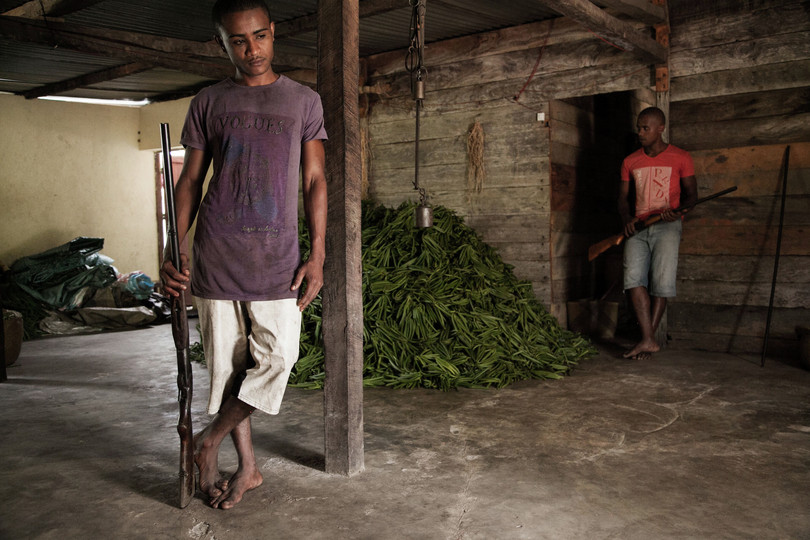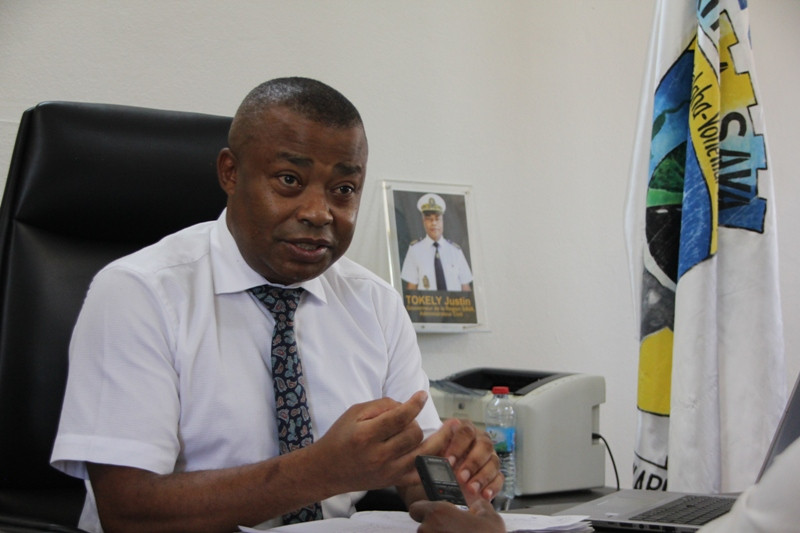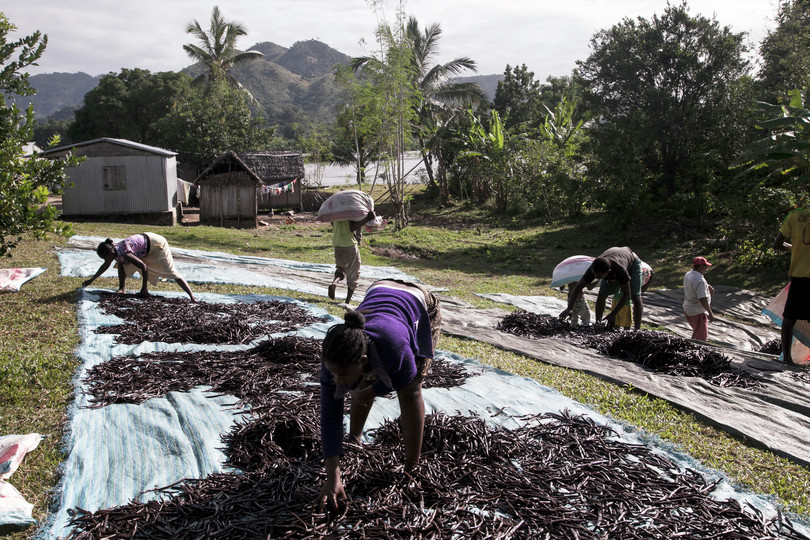Madagascar’s vanilla industry has become a magnet for corruption, money laundering and criminality.
As much as 80% of the world’s vanilla is grown in the mountainous regions of Madagascar1 by smallholder farmers who must painstakingly pollinate each vanilla blossom by hand.2 A boom in vanilla prices – driven in part by low harvest years, rising demand for natural vanilla flavouring and speculation by intermediary buyers in the market – saw international vanilla prices increase tenfold between 2013 and 2018.3 At the peak of the boom in 2018, vanilla was traded internationally at prices higher than silver.4 The ‘vanilla fever’ has made some producers rich, but has been described as a ‘short-lived El Dorado’,5 bringing with it insecurity, criminality and corruption.6
Vanilla farmers have been subjected to organized thefts of their prize crop, some of which have ended in violence, either with farmers killed attempting to protect their produce or would-be thieves being executed in forms of mob justice.7 Reports have found the vanilla market to be a site of money laundering and of corruption.8
Much of this turmoil has been centred in the Sava region, in Madagascar’s north-east, which for years has been the main region for vanilla production,9 and where up to 90% of the regional population are reliant on vanilla cultivation.10 Yet as prices began to fall from their 2018 highs – to the point where in February 2020 the government imposed a minimum price for exported vanilla in an attempt to stabilize the market11 – criminality in the vanilla trade has also changed. Thefts have begun to affect other nascent vanilla-producing regions, and new patterns of money laundering and corruption have emerged.

Armed guards protect harvested vanilla in the municipality of Bemalamatra, near Madagascar’s northern Sava region. The region is the centre of vanilla production in the country and has been affected by organized thefts and criminality affecting the vanilla market in recent years.
Photo: Rijasolo/AFP via Getty Images
A bitter taste for farming communities
According to Captain Maurille Ratovoson, commander of the regional gendarmerie, law enforcement has recorded several types of criminality in relation to vanilla in the Sava region, particularly in Antalaha. Firstly, there are thefts of vanilla from the fields, which happen regularly between March and July at the time that the official harvest starts, and thefts of stored vanilla, ready for sale.12 These thefts can sometimes turn violent, as would-be thieves can be armed with long knives or firearms.13 The public prosecutor in Antalaha, Alain Patrick Randriambololona, confirmed these reports, adding that there have also been cases of poisonings and attempted murders during attempted vanilla thefts.14

Tokely Justin, governor of Madagascar’s Sava region, discusses the impact of organized criminality on the vanilla trade.
Riana Raymonde Randrianarisoa
Secondly, there are scams and frauds carried out between the growers and the ‘collectors’ (the intermediaries who collect vanilla from farmers), between collectors themselves and between the higher-level operators, who employ vanilla collectors and who also export vanilla. For example, vanilla collectors may take the produce yet never deliver on promised payments to growers. ‘These types of crimes rise particularly … before and after the official harvest,’ says Ratovoson. ‘The victims take time to come forward because they are waiting on payments from the bigger operators’ – payments that never appear.15
For the governor of Sava region, Tokely Justin, the fight against vanilla thefts should not only be limited to police and the criminal justice system. He encourages collaboration between the vanilla operators and the local population. For Justin, this is a political priority, especially for the next harvest, which promises to be an abundant one.16
But some farmers, faced with potentially devastating losses from theft, have turned to private protection. Romuald Bemaharambo, a farmer in the Sambava district of the Sava region, describes the actions he must take to protect his crop. ‘We are obligated to pay guards during the nine months of vanilla growth until the harvest starts,’ he said. ‘Personally, I pay around 400 000 ariary [around US$100] each month to keep my plants, the flowers and especially the stocks of harvested vanilla from the moment that harvests are authorized, which is to say my annual expenses for security are around 3 600 000 ariary per year [just over US$900].17 It’s a significant sum, because at the moment with prices falling on the local market and the price limits on export, I find myself in the red!’ 18
While the cost of such security leaves a bitter taste for farmers such as Bemaharambo, vanilla-related criminality in the Sava region is actually declining, according to statistics shared by the regional gendarmerie. Randriambololona, the prosecutor, attributes this to the regional authorities’ zero-tolerance approach towards vanilla-related crimes.19
However, thefts have risen in up-and-coming vanilla-producing regions. According to growers in the Atsimo Antsinana region in the south-east of Madagascar, thefts of ‘green’ vanilla directly from the plant are on the rise, especially just before harvest time. Victor Faniny, vice president of the region’s vanilla policy platform, confirms this trend, which stymies the development of the market, as vanilla picked early is of lesser quality.20
According to Norbert Monja, a vanilla farmer in the south-east: ‘This situation affects the quality of the vanilla, and the financial resources of households. On the one hand, we have to pick the vanillas early to avoid theft. On the other hand, we also pay security guards 300 000 ariary [US$76] per person every three months. Since we do not yet have clients to buy our produce … we are in a loss-making situation,’ he says.21
There are allegations that these thefts are part of a strategic criminal approach that leaves the farmers little choice but to sell to criminal actors. Aline Harisoa, a representative of the Tsara Hevitsy association, part of a coalition of civil society organizations in Farafangana, south-east Madagascar, describes such an arrangement: ‘The mafias order the theft of vanilla … Then they themselves encourage the farmers to sell the vanilla, still on the plant, at derisory prices. Then, if this offer is accepted, the operators do not pay the agreed amounts at harvest time … abusing the population’s trust,’ she says.22
Colonel Derbas Behavana, commander of the National Gendarmerie in Farafangana, acknowledges that ‘the mafia networks are strong and tightly knit’, making it hard to identify those who are organizing the thefts.23 However, law enforcement and judicial sources believe that a select few of the high-level vanilla operators are, in reality, the commanders of thieving gangs, either paying the thieves directly and buying stolen vanilla at bargain price, or simply taking the stolen vanilla in return for a part in the profits. Local communities, elected officials and regional authorities in the south-east likewise argue that bands of thieves are paid and organized by vanilla operators from other regions, particularly the Sava region. Other intermediaries in the vanilla market are also suspected of covertly buying stolen produce and then selling it on to operators for export at standard market price.
But such allegations may also have more complex motives. Competition between vanilla-growing regions drives suspicion between producers, leading them to accuse producers of other regions of masterminding the vanilla thefts.24 A high-level vanilla operator in Farafangana, who spoke to the GI-TOC on condition of anonymity for his safety, said ‘we are victims of speculation and unfair competition from more experienced operators based in the Sava region or other producing regions. It should be remembered that there are currently more than 10 vanilla-producing districts in Madagascar. The Sava operators are afraid of the quality of our products and the quantities of our vanilla. So they seek to damage our image.’25 Désiré Andriamarikita, mayor of the commune of Vohimalaza, Vaingandrano district, likewise believes that bad-faith operators from other regions are behind the thefts, attempting to harm the sector as it develops in the south.26
Figure 3 Thefts and armed robberies of vanilla in the Sava region, in kilograms.
NOTE: Data from the regional gendarmerie suggests that vanilla-related crime has fallen since 2018, when a price bubble in the vanilla market pushed the commodity to record prices. Recent reports suggest that vanilla thefts are rising in other regions that are beginning to produce more vanilla.
SOURCE: Gendarmerie, Sava region

Treated vanilla is dried in the sun in the Sava region, Madagascar. Reports of organized vanilla thefts include thefts of ‘green’ vanilla directly from the vine or harvested stores, as well as thefts of treated and prepared vanilla.
Photo: Rijasolo/AFP via Getty Images
Shifting patterns of money laundering
Activists and companies in the vanilla business have argued that vanilla prices have been artificially inflated by rosewood traders speculatively buying into vanilla as a form of trade-based money laundering,27 and that the leading businesspeople controlling the vanilla trade are also trafficking rosewood. (The illegal trade in rosewood is one of Madagascar’s most significant illicit markets.)28
Yet with vanilla prices falling, modes of money laundering have shifted. In an attempt to bring stability to the market, the Malagasy government imposed a legal minimum export price for vanilla from February 2020, first at US$350 per kilogram,29 then US$250 per kilogram.30 While the aim of this policy was to preserve the businesses of smallholder producers,31 there has been a sharp fall in prices on the domestic market as buyers, hesitant to export vanilla at a price higher than other international offerings, are unwilling to commit to buying produce.32 Debates between some growers who prefer to allow the market to regulate itself33 and those in support of the minimum price34 have been fierce.
Two high-level vanilla operators speaking under condition of anonymity argued that the minimum price policy has given rise to a new form of corruption and money laundering.35 A select few vanilla exporters, they allege, have the privilege of exporting vanilla at US$125–US$150 per kilogram – well below the imposed minimum price. While the ability to export at a lower price may not seem like a privilege, it allows these exporters to sell at an internationally competitive rate, unencumbered by the regulations that are making international business difficult for other exporters. These exporters reportedly enjoy high-level protection and their (illegal) special status is widely known.
The means of disguising such transactions is relatively simple. Firstly, the exporter and overseas buyer agree on paper to a US$250 per kilogram sale of vanilla. After the transaction is concluded, the Malagasy party returns the difference between the US$250 per kilogram and the real (lower) price back to the overseas buyer. This may take place after the money is laundered through other business activities.36
According to prominent environmental activist Clovis Razafimalala, founder of environmental watchdog group Coalition Lampogno, a significant number of major vanilla operators who are former rosewood traffickers have also been taking advantage of this scheme to launder the profits of rosewood trafficking.37 By exporting vanilla at US$150 per kilogram, US$100 of additional funds (in this case rosewood profits held in offshore accounts) is added to payments to reach the required US$250 limit. This allows the profits of rosewood trafficking to be brought back into Malagasy banks without detection.
Madagascar is currently facing several considerable challenges: the financial and health impact of the pandemic and severe drought in some southern regions. It seems also that the vanilla market – one of the country’s key exports – is facing an uncertain time, as the rush of demand for the highly prized spice has engendered criminality and insecurity.
Notes
-
Nielsen-Massey, Crop report: February 2021, https://nielsenmassey.com/wp-content/uploads/2021/02/Feb-2021_Crop_Report.pdf; Wendell Steavenson, PHOTOS: Vanilla Boom Is Making People Crazy Rich — And Jittery — In Madagascar, NPR, 15 September 2019, https://www.npr.org/sections/goatsandsoda/2019/09/15/757899271/photos-vanilla-boom-is-making-people-crazy-rich-and-jittery-in-madagascar. ↩
-
See Dan Nosowitz, How Did Madagascar Become the World’s Biggest Producer of Vanilla?: A tale of a botanical mystery, colonialism, and savvy marketing, Atlas Obscura, 10 December 2020, https://www.atlasobscura.com/articles/madagascar-vanilla. ↩
-
Wendell Steavenson, PHOTOS: Vanilla Boom Is Making People Crazy Rich — And Jittery — In Madagascar, NPR, 15 September 2019, https://www.npr.org/sections/goatsandsoda/2019/09/15/757899271/photos-vanilla-boom-is-making-people-crazy-rich-and-jittery-in-madagascar. ↩
-
David Pilling, The real price of Madagascar’s vanilla boom, Financial Times, 5 June 2018, https://www.ft.com/content/02042190-65bc-11e8-90c2-9563a0613e56. ↩
-
Zucco Marion, A Madagascar, quel avenir pour la vanille ? L’or noir en péril, Entreprenante Afrique, 20 June 2019, https://www.entreprenanteafrique.com/a-madagascar-quel-avenir-pour-la-vanille-lor-noir-en-peril/. ↩
-
Dan Nosowitz, How did Madagascar become the world’s biggest producer of vanilla?: A tale of a botanical mystery, colonialism, and savvy marketing, Atlas Obscura, 10 December 2020, https://www.atlasobscura.com/articles/madagascar-vanilla; Wendell Steavenson, Photos: Vanilla boom is making people crazy rich — and jittery — in Madagascar, NPR, 15 September 2019, https://www.npr.org/sections/goatsandsoda/2019/09/15/757899271/photos-vanilla-boom-is-making-people-crazy-rich-and-jittery-in-madagascar; Ingrid Gercama and Nathalie Bertrams, Vanilla fever: Fear sours the sweet scent of Madagascar’s success, Mail and Guardian, 16 March 2018, https://mg.co.za/article/2018-03-16-00-vanilla-fever-fear-sours-the-sweet-scent-of-madagascars-success/. ↩
-
Jonathan Watts, Madagascar’s vanilla wars: prized spice drives death and deforestation, Gulf News, 31 March 2018, https://gulfnews.com/world/africa/madagascars-vanilla-wars-prized-spice-drives-death-and-deforestation-1.2197215; Sarah R Osterhoudt, ‘“Nobody wants to kill”: Economies of affect and violence in Madagascar’s vanilla boom, American Ethnologist, 10 August 2020, https://doi.org/10.1111/amet.12911. ↩
-
Jonathan Watts, Madagascar’s vanilla wars: prized spice drives death and deforestation, Gulf News, 31 March 2018, https://gulfnews.com/world/africa/madagascars-vanilla-wars-prized-spice-drives-death-and-deforestation-1.2197215. ↩
-
The Sava region is so-called following the first letters of its four main towns: Sambava, Antahala, Iharana (also known as Vohimaro) and Andapa. ↩
-
Interview with Tokely Justin, governor of the Sava region, Antahala February 2021. ↩
-
Laetitia Bezain, Vol de vanille verte en hausse avant l’ouverture de la récolte, RFI, 28 May 2020, https://www.rfi.fr/fr/podcasts/20200528-vol-vanille-verte-en-hausse-avant-l-ouverture-la-récolte. ↩
-
Interview with Maurille Ratovoson regional gendarmerie commander, Sava region February 2021. ↩
-
Summary of interviews with members of the gendarmerie and with prosecutors, Sava region February 2021. ↩
-
Interview with Alain Patrick Randriambololona, public prosecutor, Antalaha, February 2021. ↩
-
Interview with Maurille Ratovoson regional gendarmerie commander, Sava region February 2021. ↩
-
Interview with Tokely Justin, governor of the Sava region, Antahala February 2021. ↩
-
Bemaharambo reported that he produces 100‒150kg of vanilla annually on his farm, and last year sold at 800 000 ariary per kilo. This makes security for the farm between one twentieth or one thirtieth of his gross revenue.Conversions done using Oanda currency converter (https://www1.oanda.com/currency/converter/)). ↩
-
Interview with Romuald Bemaharambo, Vohemar, Sambava district, Sava region, February 2021. ↩
-
Interview with Alain Patrick Randriambololona, public prosecutor, Antalaha, February 2021. ↩
-
Interview with Victor Faniny, Atsimo Antsinana region, July 2021. The vanilla policy platform serves as a regional body bringing together operators, producersd, exporters and elected officials . ↩
-
Interview with Norbert Monja, vanilla farmer Farafangana region, July 2021. ↩
-
Aline Harisoa, a representative of the Tsara Hevitsy association, Farafangana region, July 2021. ↩
-
Colonel Behavana, commander of the National Gendarmerie in Farafangana [date and location]. ↩
-
Sarah R Osterhoudt, “Nobody wants to kill”: Economies of affect and violence in Madagascar’s vanilla boom, American Ethnologist, 10 August 2020, https://doi.org/10.1111/amet.12911 ↩
-
Interview with high-level vanilla operator in Farafangana, July 2021. ↩
-
Désiré Andriamarikita, mayor of the commune of Vohimalaza, Vaingandrano district, July 2021. ↩
-
See Mark Ford, Madagascar’s rosewood traffickers laundering through the vanilla trade, Trade Based Financial Crimes News, 3 April 2018, https://amlnewsflow.coastlinesolutions.com/2018/04/03/madagascars-rosewood-traffickers-laundering-through-the-vanilla-trade/ and Ingrid Gercama and Nathalie Bertrams, Vanilla fever: Fear sours the sweet scent of Madagascar’s success, Mail & Guardian, 16 March 2018, https://mg.co.za/article/2018-03-16-00-vanilla-fever-fear-sours-the-sweet-scent-of-madagascars-success/. ↩
-
See the GI-TOC’s Organised Crime Index for an assessment of the relative power of criminal markets and criminal actors in Madagascar: https://ocindex.enactafrica.org/country/madagascar. ↩
-
Laetitia Bezain, Vol de vanille verte en hausse avant l’ouverture de la récolte, RFI, 28 May 2020, https://www.rfi.fr/fr/podcasts/20200528-vol-vanille-verte-en-hausse-avant-l-ouverture-la-récolte. ↩
-
Laetitia Bezain, Madagascar: début morose pour la campagne d’exportation de vanille, RFI, 3 November 2020, https://www.rfi.fr/fr/afrique/20201102-madagascar-campagne-morose-exportation-vanille. ↩
-
Marcel Goldenberg, Mintec: Vanilla prices will fall further in the next three months, Commodafrica, 6 July 2020, http://www.commodafrica.com/06-07-2020-marcel-goldenberg-mintec-vanilla-prices-will-fall-further-next-three-months. ↩
-
R Mandrimbisoa, Vanille : prix trop élévé selon le contexte mondial ?, Madagascar Tribune, 3 March 2021, https://www.madagascar-tribune.com/Vanille-prix-trop-eleve-selon-le-contexte-mondial.html and Harilalaina Rakotobe, Exportation, le prix du kilo de vanilla en chute libre, L’Express de Madagascar, 11 November 2020, https://lexpress.mg/11/11/2020/exportation-le-prix-du-kilo-de-vanille-en-chute-libre/. ↩
-
Tolotra Jerry Randriamihaja, ‘Il faut supprimer le prix plancher de la vanille’, L’Express de Madagascar, 23 November 2020, https://lexpress.mg/23/11/2020/tolotra-jerry-randriamihaja-il-faut-supprimer-le-prix-plancher-de-la-vanille/. ↩
-
Lettre ouverte aux operateurs pronant le prix d’exportation du kilo de la vanille a l’export a 150 USD contrairement aux directives du MICA a 250 USD, La Verité, 28 July 2020, https://laverite.mg/economie/item/11028-lettre-ouverte-aux-operateurs-pronant-le-prix-d’exportation-du-kilo-de-la-vanille-a-l’export-a-150-usd-contrairement-aux-directives-du-mica-a-250-usd.html. ↩
-
Interviews, two high-level vanilla operators Atsimo Antsinana region, July 2021. ↩
-
Interviews, two high-level vanilla operators Atsimo Antsinana region, July 2021. ↩
-
Interview with Clovis Razafimalala, environmental activist and founder of Coalition Lampogno, by phone, 8 July 2021. ↩
